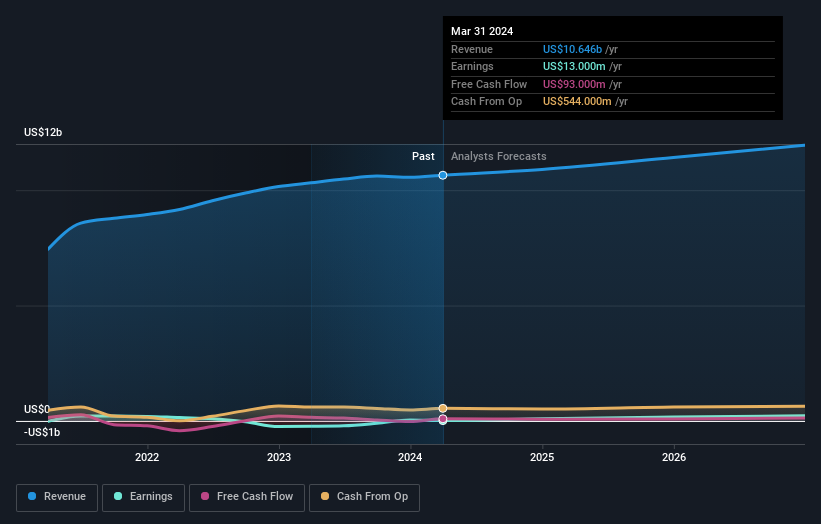Investors in Dana Incorporated (NYSE:DAN) had a good week, as its shares rose 8.8% to close at US$13.32 following the release of its quarterly results. It looks like a pretty bad result, all things considered. Although revenues of US$2.7b were in line with analyst predictions, statutory earnings fell badly short, missing estimates by 79% to hit US$0.02 per share. The analysts typically update their forecasts at each earnings report, and we can judge from their estimates whether their view of the company has changed or if there are any new concerns to be aware of. We thought readers would find it interesting to see the analysts latest (statutory) post-earnings forecasts for next year.
Check out our latest analysis for Dana
Taking into account the latest results, the current consensus from Dana’s eight analysts is for revenues of US$10.9b in 2024. This would reflect a satisfactory 2.4% increase on its revenue over the past 12 months. Statutory earnings per share are predicted to shoot up 606% to US$0.63. In the lead-up to this report, the analysts had been modelling revenues of US$10.9b and earnings per share (EPS) of US$0.55 in 2024. There was no real change to the revenue estimates, but the analysts do seem more bullish on earnings, given the decent improvement in earnings per share expectations following these results.
There’s been no major changes to the consensus price target of US$14.88, suggesting that the improved earnings per share outlook is not enough to have a long-term positive impact on the stock’s valuation. The consensus price target is just an average of individual analyst targets, so – it could be handy to see how wide the range of underlying estimates is. There are some variant perceptions on Dana, with the most bullish analyst valuing it at US$18.00 and the most bearish at US$13.00 per share. Analysts definitely have varying views on the business, but the spread of estimates is not wide enough in our view to suggest that extreme outcomes could await Dana shareholders.
Taking a look at the bigger picture now, one of the ways we can understand these forecasts is to see how they compare to both past performance and industry growth estimates. It’s pretty clear that there is an expectation that Dana’s revenue growth will slow down substantially, with revenues to the end of 2024 expected to display 3.2% growth on an annualised basis. This is compared to a historical growth rate of 7.1% over the past five years. By way of comparison, the other companies in this industry with analyst coverage are forecast to grow their revenue at 11% per year. So it’s pretty clear that, while revenue growth is expected to slow down, the wider industry is also expected to grow faster than Dana.
The Bottom Line
The biggest takeaway for us is the consensus earnings per share upgrade, which suggests a clear improvement in sentiment around Dana’s earnings potential next year. On the plus side, there were no major changes to revenue estimates; although forecasts imply they will perform worse than the wider industry. The consensus price target held steady at US$14.88, with the latest estimates not enough to have an impact on their price targets.
Keeping that in mind, we still think that the longer term trajectory of the business is much more important for investors to consider. At Simply Wall St, we have a full range of analyst estimates for Dana going out to 2026, and you can see them free on our platform here..
You should always think about risks though. Case in point, we’ve spotted 3 warning signs for Dana you should be aware of, and 1 of them is significant.
Have feedback on this article? Concerned about the content? Get in touch with us directly. Alternatively, email editorial-team (at) simplywallst.com.
This article by Simply Wall St is general in nature. We provide commentary based on historical data and analyst forecasts only using an unbiased methodology and our articles are not intended to be financial advice. It does not constitute a recommendation to buy or sell any stock, and does not take account of your objectives, or your financial situation. We aim to bring you long-term focused analysis driven by fundamental data. Note that our analysis may not factor in the latest price-sensitive company announcements or qualitative material. Simply Wall St has no position in any stocks mentioned.
